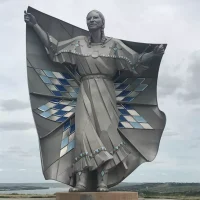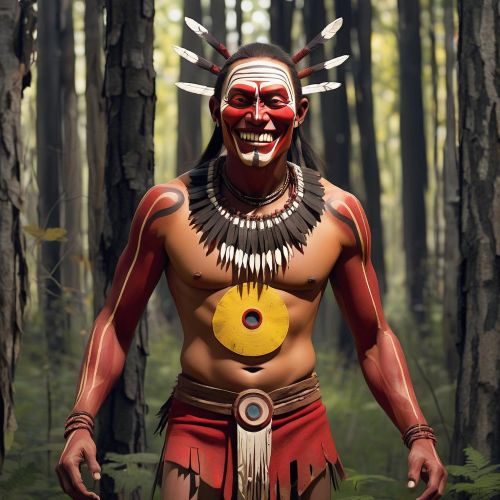White Buffalo Calf Woman : Divine Guide of the Lakota People
Listen
At a glance
| Description | |
|---|---|
| Origin | North American Mythology |
| Classification | Spirits |
| Family Members | N/A |
| Region | United States of America |
| Associated With | Messenger |
White Buffalo Calf Woman
Introduction
White Buffalo Calf Woman (Lakȟótiyapi: Ptesáŋwiŋ) stands as one of the most sacred figures in Lakota and Dakota spirituality. Her story is not just a myth but a living foundation of cultural identity, ceremonial life, and Indigenous ecological philosophy. According to Lakota oral tradition, she appeared during a time of famine, emerging first as a mysterious white buffalo calf before transforming into a radiant woman. Her arrival marked a turning point for the people, bringing the Čhaŋnúŋpa (sacred pipe) and the Seven Sacred Rites, which established the core of Lakota ceremonial practice.
Her teachings emphasized balance with nature, the significance of the buffalo, and the deep spiritual connection between humans and the land. More than a historical legend, she remains a guiding force whose prophecy of peace and renewal continues to echo among Indigenous communities today.
Physical Traits
The physical appearance of White Buffalo Calf Woman is deeply symbolic, reflecting both purity and divine authority. She is often described as a young woman in white buckskin, carrying an aura of serenity and spiritual brilliance. Her long black hair and calm, penetrating gaze reflect her sacred nature, while the immaculate white clothing she wears signifies holiness and the purity of her mission.
One of the most profound aspects of her physical presence is her ability to transform. After completing her teachings, she changed into a white buffalo calf—an animal considered extremely sacred due to its rarity. As she walked away, she transformed again into buffalo of four colors: white, yellow, red, and black, representing the four directions and the unity of all peoples. These transformations underscore her connection to the natural world and her role as a divine bridge between realms.
Family
Traditional Lakota and Dakota teachings do not describe White Buffalo Calf Woman as having a human family. Instead, she is regarded as a spiritual being sent by Wakan Tanka, the Great Mystery. Her origins are rooted in the sacred rather than the earthly, making her a divine emissary rather than a figure defined by lineage.
Her “family,” in a spiritual sense, is the Lakota nation itself, whom she guides and nurtures through ceremony and teaching. Many contemporary interpretations also associate her with the Buffalo Nation, a sacred kinship symbolizing abundance, resilience, and the interdependence of all living beings. In this way, White Buffalo Calf Woman transcends the boundaries of familial structure, embodying the universal mother and guardian of life.
Other names
Across different communities and teachings, White Buffalo Calf Woman is known by several names that honor her sacred role. Her Lakota name Ptesáŋwiŋ translates directly to “White Buffalo Calf Woman,” reflecting her dual nature as both animal and divine messenger. In some traditions, she is associated with Woope, the spirit of peace, aligning with her teachings of harmony among peoples and with the natural world.
Her connection to the prophecy of the white buffalo—foretelling spiritual renewal and unity—has also given her broad recognition among other Indigenous nations. The symbolism of her four transformations links her to universal themes of balance, inclusion, and the sacred directions, reinforcing her role as a guide to all humanity.
Powers and Abilities
White Buffalo Calf Woman embodies profound spiritual power. Her most significant gift to the Lakota people is the Seven Sacred Rites, which include the Sweat Lodge, Vision Quest, Naming Ceremony, and Sun Dance. These rituals form the cornerstone of Lakota spiritual life, providing pathways for healing, prayer, cleansing, and reconnection with the Creator.
She also brought the Čhaŋnúŋpa, the sacred pipe, teaching the people how to use it to pray, honor creation, and maintain spiritual balance. Her mastery of shape-shifting—transforming into a white buffalo calf and later into buffalo of four colors—demonstrates her control over the natural and spiritual realms. These transformations symbolize renewal, unity, and the cyclical essence of life.
Beyond her ceremonial gifts, she offers moral guidance, instructing the people to live with respect, humility, and harmony. Her presence radiates peace, and her teachings continue to influence Indigenous environmental ethics and cultural preservation.
Modern Day Influence
The influence of White Buffalo Calf Woman remains powerful in the modern world, both within Lakota and Dakota communities and across global Indigenous movements. Ceremonies that she established continue to be practiced, preserving a lineage of spiritual knowledge that has survived centuries of cultural suppression.
The birth of a white buffalo calf, which has occurred several times in recent decades, is celebrated as a sacred sign of her return and a call for unity and environmental stewardship. These events attract widespread attention, reinforcing her message of balance and renewal.
Her teachings also resonate strongly within contemporary activism. Movements such as the resistance at Standing Rock honor her legacy by defending water, land, and community rights. In art, literature, and education, she stands as a symbol of hope, cultural revival, and Indigenous sovereignty.
White Buffalo Calf Woman’s legacy continues to inspire a renewed commitment to living in harmony with the Earth—a message that grows increasingly relevant in an age of ecological crisis and social fragmentation.
Related Images
Source
“The Legend of White Buffalo Calf Woman | Inspiration for the Spirit.” (2016). Inspiration for the Spirit. Retrieved from https://inspirationforthespirit.com/white-buffalo-calf-woman
“White Buffalo Calf Woman | Meaning & Significance.” (2025). About My Brain. Retrieved from https://aboutmybrain.com/articles/white-buffalo-calf-woman
Chasing Horse, J. (n.d.). Story of the White Buffalo Calf Woman. The Peoples Paths. Retrieved from https://thepeoplespaths.net/story-white-buffalo-calf-woman
“White Buffalo Calf Woman Teachings.” (2013). Mettahu WordPress. Retrieved from https://mettahu.wordpress.com/teachings-white-buffalo-calf-woman
“White Buffalo Woman – Lakota Legend & Meaning.” (2025). Akta Lakota. Retrieved from https://aktalakota.stjo.org/white-buffalo-woman
“White Buffalo Calf Woman – Wikipedia.” (2003). Wikipedia. Retrieved from https://en.wikipedia.org/wiki/White_Buffalo_Calf_Woman
“White Buffalo Calf Woman: The Origin of Culture Through Prophecy.” (2022). Community Stories. Retrieved from https://communitystories.ca/white-buffalo-calf-woman
Hartman, M. (2018). White Buffalo Calf Women March – Hood Museum. Dartmouth College. Retrieved from https://hoodmuseum.dartmouth.edu/white-buffalo-calf-women-march
Frequently Asked Questions
Who is White Buffalo Calf Woman in Lakota mythology?
She is a divine messenger who brought the sacred pipe and the Seven Sacred Rites, forming the foundation of Lakota spirituality.
What does the white buffalo calf symbolize?
It represents purity, renewal, spiritual awakening, and the fulfillment of prophecy.
Why is the birth of a white buffalo considered sacred?
Lakota tradition sees it as a sign of White Buffalo Calf Woman’s return and a call for unity, balance, and peace.
What ceremonies did White Buffalo Calf Woman teach?
She introduced the Seven Sacred Rites, including the Sweat Lodge, Vision Quest, and Sun Dance.
How is White Buffalo Calf Woman honored today?
Through ceremonies, cultural preservation, environmental activism, and celebrations when white buffalo calves are born.









